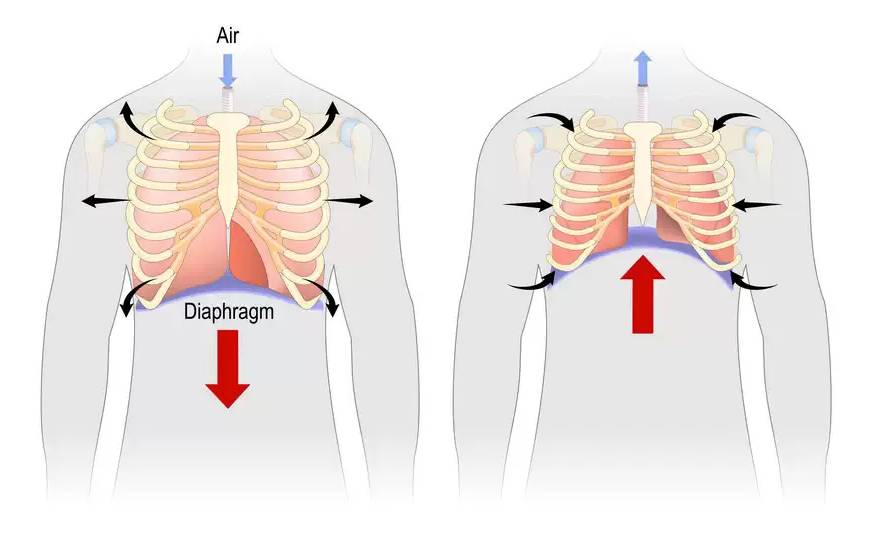
When engaging in vocal exercises, it’s essential to understand the reasoning behind each exercise and avoid blindly following an exercise without comprehending their effects on the voice. The following voice warm ups for singing are designed to help you make your voice warm up more effective as well as help you develop an understanding of your individual instrument, which is your voice! For best results, it’s important to practise daily.
For more in depth information on how to improve your singing technique, be sure to read our ultimate beginners guide on how to improve your singing.
Warm Ups for Singing Exercise #1: Breath Support
I occasionally refer to this exercise as the ‘diaphragm stretch’, which people may recognize as the concept of diaphragm support. However, the important thing to remember is to engage your core, which includes our abdominal and back muscles. This will create the necessary resistance, while exhaling to keep your voice supported while you sing. This is one of the best warm ups for singing, because it connects you to different mechanisms of your body that are involved in singing.
To understand what is happening in your body while you do this exercise, you can visualize the lowering of the diaphragm as the lungs fill up with air and the rib cage expands. While you exhale, the diaphram slowly comes back up in a controlled fashion, until you release the remaining air.

Voice Warm Ups for Singing Exercise #2: Sing High Notes, Using Lip Trills and Sirens
The purpose of this second voice warm up exercise is to help you access different parts of your voice while allowing you to sing outside of your normal vocal range. Often singers have a natural or comfortable voice range and struggle to sing higher notes. Through the following exercises, which including singing in a sing-songy manner, lip trills and Sirens, I have had great results in helping my students extend their vocal range.
How does the sing-song approach work?
Using a sing-song approach can help singers reach higher notes because it promotes proper vocal technique and breath control. When singing high notes, it is important to use proper breath support and maintain good vocal posture to avoid straining the voice.
The Lip Roll Exercise
The lip roll is considered to be an SOVT (semi-occluded vocal tract) exercise. This exercise is one of the best voice warm ups for singing and can be helpful in improving your voice technique while helping to prevent vocal nodules. This is because lip trills can help reduce vocal strain and promote proper vocal technique. Semi-occluded vocal tract exercises involve partially blocking the airflow through the vocal tract, which can help reduce the amount of pressure on the vocal cords while singing or speaking.
By using SOVT exercises regularly, singers and speakers can improve their vocal endurance.
Sirens
Sirens can also help singers warm up their voices before a performance or practice session. By gradually moving through their vocal range and gradually increasing the intensity of their singing, singers can loosen up their vocal cords and prepare their voice for more demanding singing.
Overall, sirens are an effective tool for improving a singer’s technique and preparing their voice for singing.
Voice Warm Ups for Singing Exercise #3: Yawning & Sighing
The next series of warm-up exercises include yawning and sighing. As I mentionned in the opening paragraph of this article, you should always understand the purpose of your singing warm up exercises. Yawning & Sighing will help you tap into the natural part of where you voice lives and resonates, without tension on the vocal cords and throat.
Here’s a couple of questions to ask yourself while you consciously exercise these common vocal sounds:
-did it feel effortless?
-did I feel any discomfort or tension in my throat?
-did I experience any differences in the expanse of my range?
When you try these unrestricted sound exercises again, ask yourself these questions.
In Conclusion
I trust that you found my post on effective voice warm ups for singing to be informative and useful. Sharing my philosophy on vocal training has been a pleasure. If you are considering scheduling singing lessons with me, I would be delighted to hear from you. My profile can be found on the Singing lessons Montreal page, where you can complete a form with your details, and I will reach out to you to schedule a session. For those searching for a singing teacher in Toronto or Vancouver, please take a moment to check out the relevant links provided.


